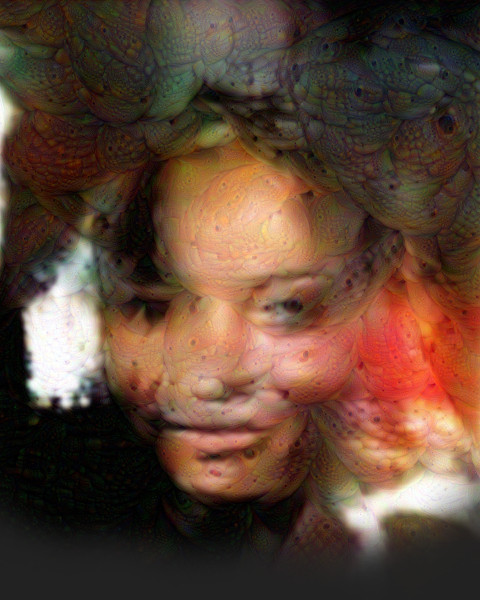

This series shows faces of people who do not exist. They are created in collaboration with artificial neural networks. The MMD-GAN neural networks studied 200,000 human faces and then generated new faces as a child would be learning what a human is from many encounters and then drawing an imaginary friend. It learned human faces with no distinction between gender, race, or age and as a result this co-creator has drawn gorgeously diverse and intriguingly unique faces. The ambiguity of gender, race, and age that we see from these faces shows the broad spectrum of human facial features that cannot be easily categorized into any stereotypical types. I see this artificial neural network not as a tool but as a co-creator. Its role goes beyond what a completely controllable tool would do and it presents its own perspective and artistic styles. Coming out of human-centric point of view, I find it important to recognize it as a collaborator for our future collaboration with more advanced A.I.s.
Please click the GALLERY button to see the works. Images in the gallery are using inner zoom tool to show details. Please wait until the detailed image is loaded if this is your first visit to this gallery.
This series is created and presented with supports from the Machine Learning department (Prof. Barnabas Poczos) at the Carnegie Mellon University and the Digital Media area (Prof. Robert Twomey) of Art department at the Youngstown State University.
MMD-GAN (Maximum Mean Discrepancy Generative Adversarial Network) is developed by Chun-Liang Li, Wei-Cheng Chang, Yu Cheng, Yiming Yang, and Barnabas Poczos. | PAPER
There is a song that my son really likes on Youtube. It is about making a monster. Weaving skeleton, arms, legs, heart, brain, and blood. Then voila! there is your new friend monster.
Once Donna Haraway remarked “Monsters signify.” Who are the monsters? They could be people who do not enjoy cucumbers, or could be immigrants, or could be humanoid robots with artificial intelligence (A.I.). The fear driven prejudice against “monsters” has been repeated at every scale of significance from the trivial to the vital in all parts of our society. Monsters are not among us but are us. Us, with our body hybridized with the internet and cell phones. Us, with our genes of mixed origins. Us, with our complex connections that can build a hypercortex (collective intelligence) such as Wikipedia.
My works try to make those “monsters” visible by creating special mirrors that reflect people's own gaze.
Sometimes by hybridizing people into the work itself using interactive audiovisual technologies. Sometimes by weaving voices of people. Sometimes by accepting A.I. as a co-creator of art.
A.I. is in fact the most recent collaborator of mine in addition to human collaborators from various disciplines. I value the diversity of people and machines that work with me. Because I like to listen, I like to watch the organized chaos of our world, I like to learn from other people's point of views in the process of art making and question why we live in a way we live now.
As a mirror would not have an image if there is no one looking at it, my art projects are completed only by people and metamorphosed by people's interaction.
I invite people to see, listen, engage, and walk out with questions about why we see what we see. As if we look at ourselves in the mirror in the morning after a drunk night out and think “Who is this?”
Eunsu Kang is a media artist from Korea. She creates interactive audiovisual installations and artworks using Machine Learning methods. Creating interdisciplinary projects, her signature has been seamless integration of art disciplines and innovative techniques. Her work has been invited to numerous places around the world including Japan, China, Switzerland, Sweden, France, Germany, and the US. All nine of her past solo shows, consisting of individual or collaborative projects, were invited or awarded. She has won the Korean National Grant for Arts three times. Her researches have been presented at conferences such as ACM, ICMC and ISEA. Kang earned her Ph.D. in Digital Arts and Experimental Media from DXARTS at the University of Washington. She received an MA in Media Arts and Technology from UCSB and an MFA from the Ewha Woman's University. She is an Associate Professor of New Media Art at the University of Akron in Ohio, USA. She is currently teaching and researching at the Art and Machine Learning departments of Carnegie Mellon University during her sabbatical year.
“The face is a central body region of sense and is also very central in the expression of emotion among humans and among numerous other species. The face is normally found on the anterior (frontal, rostral) surface of the head of animals or humans, although not all animals have faces. The face is crucial for human identity, and damage such as scarring or developmental deformities have effects stretching beyond those of solely physical inconvenience.”
[Wikipedia]